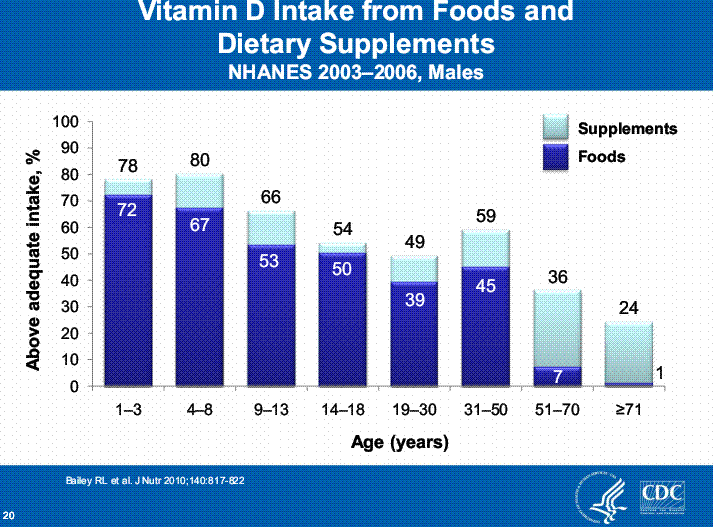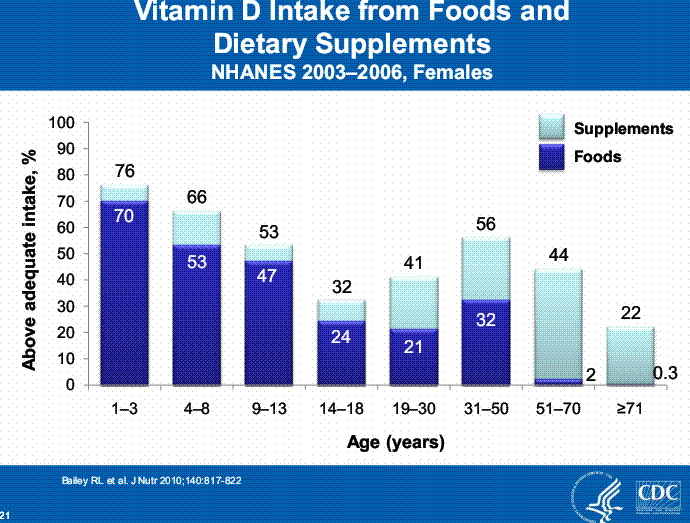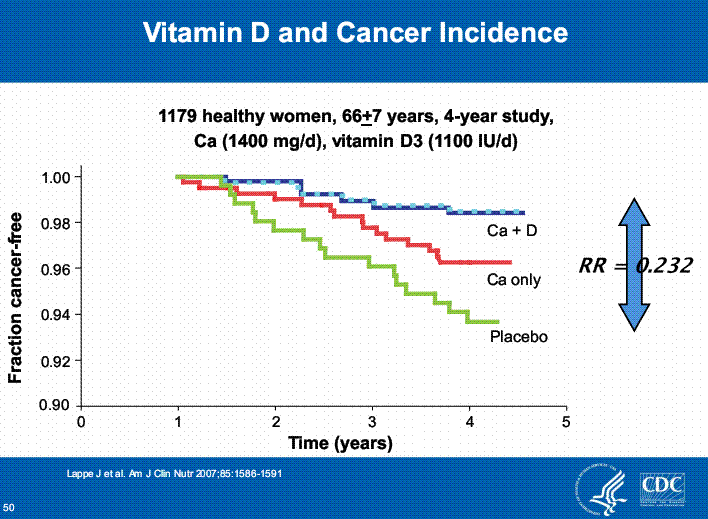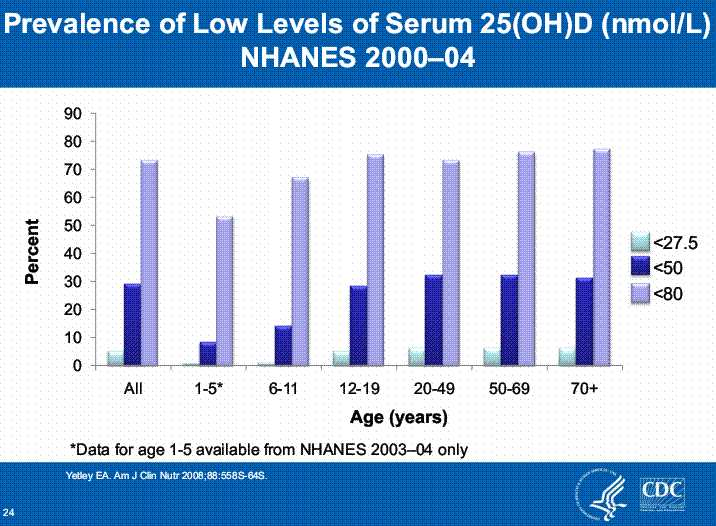CDC Vitamin D Grand Rounds
[tiki-download_file.php?fileId=1404]
-=Highlights from PDF=-
Groups at Risk of Vitamin D Deficiency
Breastfed infants
Older adults
People with limited sun exposure
People with dark skin
People with fat malabsorption
People who are obese or who have undergone gastric bypass surgery
Note from video: Inverse care law for medicine = Those who need it the most get it the least
New Blood tests have <8% day-to-day variation
Isotope Dilution Tandem Mass Spectrometry Coupled to Liquid Chromatography (LC-MS/MS)
Precision <8% day-to-day variation CLICK HERE to see other references on vitamin D blood testing
Findings from the Second Systematic Review
Infant growth: Most studies found no effect
Cardiovascular disease
– Randomized controlled trials: No effect
– Cohort studies: Variable association
Randomized controlled trials: No effect
Cohort studies: Variable association
Body weight: No effect
Cancer: No effect
Infectious diseases: No effect
Pregnancy outcomes: Inadequate data
All-cause mortality: Inconsistent data
Hypertension: Inconsistent data
- Chung M et al: Am J Clin Nutr 2010;92:273-276
Women’s Health Initiative
NIH-sponsored: http://www.nhlbi.nih.gov/whi
Largest intervention trial in history: >160,000 women
One of the substudies randomized women to vitamin D and calcium for a 7– year period to examine potential effects on hip fractures
www.nhlbi.nih.gov/whi
Trial Results after 7 Years
Hip fractures: 12% decrease, not significant
– 21% decrease for women aged 60-80 years at baseline
– 29% decrease among women who took 80% of pills
Note: WHI only used 400 IU CLICK HERE for many other studies which DID find a significant difference
Improved hip bone density
Other fractures: No differences self-reported vertebral, lower arm/wrist, total)
Kidney stones
– Significantly increased 17% (5 per 10,000/year)
Note: WHI used too much Calcium
Recommendations Made by Professional Groups
American Academy of Pediatrics 400 IU for children
Canadian Paediatric Society
– Weight-based intake for children
– Up to 2000 IU for pregnant and lactating women
American Academy of Dermatology
– More from supplements, not more sun exposure
National Osteoporosis Foundation, International Osteoporosis Foundation
-400-800 IU for adults <50 years; 800-1000 IU >50 years
Notes from video question and answer section
Not noticing relationship between rates of osteo nor Cancer with decreases in vitamin D
PTH suppression - at 20 ng or 30 ng?
References
American Academy of Pediatrics: www.aap.org/healthychildren/09s_bts/Vitamin%20D.pdf
Canadian Paediatric Society: www.cps.ca/english/statements/ii/fnim07-01.htm
American Academy of Dermatology: www.aad.org/forms/policies/uploads/ps/ps-vitamin%20d.pdf
% males with more than 'Adequate Intake' (200, 400, 600 IU)

% of females with more than 'Adequate Intake' (200, 400, 600 IU)

Cancer incidence

CLICK HERE for Original study by Lappe - 2007
CLICK HERE for Lappe -2011 slide description of original study
Deficiency definitions have strong impact on determining what percentage of the population is deficient
Definitions in ng/ml are 11, 20, and 32

Kevin DeCock, MD, F.R.C.P., Director, Center for Global Health (CDC)
Cynthia Whitney, MD, MPH, Chief of the Respiratory Diseases Branch, Division of Bacterial Diseases, National Center for Immunization and Respiratory Diseases (CDC)
Robert Quick, MD, MPH, Medical Epidemiologist, Division of Foodborne, Waterborne, and Environmental Diseases, National Center for Emerging and Zoonotic Infectious Diseases (CDC)
Brent Burkholder, MD, MA, Director, Global Immunization Division, National Center for Immunization and Respiratory Diseases (CDC)
Discussants:
Nancy Binkin, MD, MPH, Chief, Policy and Evidence Unit, UNICEF
Facilitated by:
Tanja Popovic, MD, PhD, Scientific Director, Public Health Grand Rounds
Shane Joiner, Communication Manager, Public Health Grand Rounds
